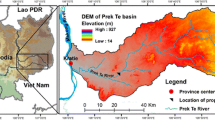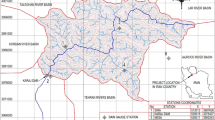Abstract
This paper demonstrates the basin/reservoir system integration as a decision support system for short term operation policy of a multipurpose dam. It is desired to re-evaluate and improve the current operational regulation of the reservoir with respect to water supply and flood control especially for real time operation. The most innovative part of this paper is the development of a decision support system (DSS) by the integration of a hydrological (HEC-HMS) and reservoir simulation model (HEC-ResSim) to guide the professional practitioners during the real time operation of a reservoir to meet water elevation and flood protection objectives. In this context, a hybrid operating strategy to retain maximum water elevation is built by shifting between daily and hourly decisions depending on real time runoff forecasts. First, a daily hydro-meteorological rule based reservoir simulation model (HRM) is developed for both water supply and flood control risk. Then, for the possibility of a flood occurrence, hourly flood control rule based reservoir simulation model (FRM) is used. The DSS is applied on Yuvacık Dam Basin which has a flood potential due to its steep topography, snow potential, mild and rainy climate in Turkey. Numerical weather prediction based runoff forecasts computed by a hydrological model together with developed reservoir operation policy are put into actual practice for real time operation of the reservoir for March – June, 2012. According to the evaluations, proposed DSS is found to be practical and valuable to overcome subjective decisions about reservoir storage.





Similar content being viewed by others
References
Ahmad S, Prashar D (2010) Evaluating municipal water conservation policies using a dynamic simulation model. Water Resour Manag 24(13):3371–3395
Ahmad S, Simonovic SP (2000) System dynamic modeling of reservoir operations for flood management. J Comput Civ Eng 14(3):190–198
Ahmed JA, Sarma AK (2005) Genetic algorithm for optimal operating policy of a multipurpose reservoir. Water Resour Manag 19(2):145–161
Alemu ET, Palmer RN, Austin P, Meaker B (2011) Decision support system for optimizing reservoir operations using ensemble streamflow predictions. J Water Resour Plan Manag 137(1):72–82
Babazadeh H, Sedghi H, Kaveh F, Jahromi H (2007) Performance evaluation of Jiroft Storage Dam operation using HEC-ResSim 2.0. Eleventh Int. Water Technology Conf., Sharm El-Sheikh, Egypt
Bolouri-Yazdeli Y, Haddad OB, Fallah-Mehdipour E, Mariño MA (2014) Evaluation of real-time operation rules in reservoir systems operation. Water Resour Manag 28(3):715–729
Charley WJ (2010) HEC-RTS (Real-Time Simulation) version 2 for real time flood forecasting and water control. 2nd Joint Federal Interagency Conf., Las Vegas, NV
Cheng C-T, Wang W-C, Xu D-M, Chau KW (2008) Optimizing hydropower reservoir operation using hybrid genetic algorithm and chaos. Water Resour Manag 22(7):895–909
Davis DW, Hanbali F (2005) Water management in Iraq — Capability restoration and implications for historic marsh restoration. Impacts of Global Climate Change, pp 1–9
Duren AMC (2009) A characterization of the non-analytical solution of the downstream control operating rule in HEC-ResSim. M.S. Thesis, Hydrologic Science, Office of Graduate Studies, The University of California, Davis, USA
Faber BA, Stedinger JR (2001) Reservoir optimization using sampling SDP with ensemble streamflow prediction (ESP) forecasts. J Hydrol 249(1–4):113–133
Holmes MGR, Young AR, Goodwin TH, Grew R (2005) A catchment-based water resource decision-support tool for the United Kingdom. Environ Model Softw 20(2):197–202
Hossain MS, El-shafie A (2013) Intelligent systems in optimizing reservoir operation policy: a review. Water Resour Manag 27(9):3387–3407
Klipsch JD, Hurst MB (2007) HEC-ResSim: reservoir system simulation, User’s manual version 3.0 CPD-82. U. S. Army Corps of Engineers, Hydrologic Engineering Center, Davis
Kumar DN, Reddy MJ (2006) Ant colony optimization for multi-purpose reservoir operation. Water Resour Manag 20(6):879–898
Labadie JW (2004) Optimal operation of multireservoir systems: state-of-art-review. J Water Resour Plan Manag 130(2):93–111
Ming B, Chang JX, Huang Q, Wang YM, Huang SZ (2015) Optimal operation of multi-reservoir system based-on cuckoo search algorithm. Water Resour Manag 29(15):5671–5687
New Castle (2001) Kirazdere reservoir operating strategy, Final project report. Water Resource Systems Research Laboratory, Department of Civil Engineering, University of Newcastle, United Kingdom
Ngo LL, Madsen H, Rosbjerg D, Pedersen CB (2008) Implementation and comparison of reservoir operation strategies for the Hoa Binh Reservoir, Vietnam using the Mike 11 Model. Water Resour Manag 22:457–472
Rani D, Moreira MM (2010) Simulation–optimization modeling: a survey and potential application in reservoir systems operation. Water Resour Manag 24(6):1107–1138
Rao Z, O’Connell PE, Cook DJ, Jamieson DG (2001) Deriving robust operating rules for the interim control of the Kirazdere Reservoir. Water Sci Technol 43(5):227–284
Scharffenberg WA, Fleming MJ (2010) HEC-HMS: hydrologic modeling system, User’s manuel version 3.5 CPD-74A. U. S. Army Corps of Engineers, Hydrologic Engineering Center, Davis
Schwanenberg D, Fan FM, Naumann S, Kuwajima JI, Montero RA, dos Reis AA (2015) Short-term reservoir optimization for flood mitigation under meteorological and hydrological forecast uncertainty. Water Resour Manag 29(5):1635–1651
Şensoy A, Şorman AA, Yener MK, Şorman AÜ (2009) HMS Model application in Yuvacık Dam reservoir, Turkey. Hydrology in Mountain Regions: Observations, Processes and Dynamics, Ed. by Danny Marks, IAHS Publ. No:326, 93–101
Sreekanth J, Datta B, Mohapatra PK (2012) Optimal short-term reservoir operation with integrated long-term goals. Water Resour Manag 26(10):2833–2850
Suiadee W, Tingsanchali T (2007) A combined simulation-genetic algorithm optimization model for optimal rule curves of a reservoir: a case study of the Nam Oon Irrigation Project, Thailand. Hydrol Process 21(23):3211–3225
Thames Water (2001) Yuvacık Dam operation Maintenance manual, vol 1. Thames Water Turkey Dam Department, Kocaeli
USACE (2010) Delaware river basin flood analysis model, Reservoir operations and streamflow routing component, Technical Report PR-73. US Army Corps of Engineers, Institute of Water Resources, Hydrologic Engineering Center, Davis
Wang H, Liu J (2013) Reservoir operation incorporating hedging rules and operational inflow forecasts. Water Resour Manag 27:1427–1438
Wurbs RA (1993) Reservoir-system simulation and optimization models. J Water Resour Plan Manag 119(4):445–472
Wurbs RA (2005) Modeling river/reservoir system management, water allocation, and supply reliability. J Hydrol 300(1–4):100–113
Yang X, Parent E, Michel C, Roche P-A (1995) Comparison of real-time reservoir operation techniques. J Water Resour Plan Manag 121(5):345–351
Yavuz O, Uysal G, Sensoy A, Sorman AA, Akgun T, Gezgin T (2012) Using HEC-HMS as a decision support system to minimize the downstream flooding risk in Yuvacık Dam basin. Proc., Conf. on Water Observation and Information Systems, BALWOIS, Ohrid, Macedonia
Yeh WW-G, Becker L, Hua S-Q, Wen D-P, Liu D-P (1993) Optimization of real-time hydrothermal system operation. J Water Resour Plann Manag 118(6):636–653
Yener MK, Şorman AÜ, Şorman AA, Şensoy A, Gezgin T (2007) Modeling studies with HEC-HMS and runoff scenarios in Yuvacik Basin, Turkey. Proc., Vol. IV, Int. Congress on River Basin Management, Antalya, Turkey
Acknowledgements
This study is supported by The Scientific and Technological Research Council of Turkey (TUBITAK) 109Y218 and Anadolu University BAP-1103F082. Thanks are extended to Akifer Ltd. Şti. for their support. Valuable contributions of Prof. Dr. A.Ünal Şorman to the improvement of this paper is gratefully acknowledged. The authors would also like thank to Koray Sağlam in scripting part for his efforts.
Author information
Authors and Affiliations
Corresponding author
Electronic supplementary material
Below is the link to the electronic supplementary material.
Online Resource 1
(GIF 98 kb)
Online Resource 2
(PDF 155 kb)
Online Resource 3
(PDF 6 kb)
Online Resource 4
(GIF 131 kb)
Rights and permissions
About this article
Cite this article
Uysal, G., Şensoy, A., Şorman, A.A. et al. Basin/Reservoir System Integration for Real Time Reservoir Operation. Water Resour Manage 30, 1653–1668 (2016). https://doi.org/10.1007/s11269-016-1242-9
Received:
Accepted:
Published:
Issue Date:
DOI: https://doi.org/10.1007/s11269-016-1242-9




